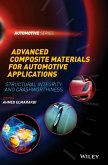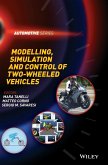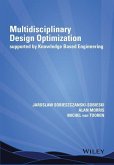Guide to Load Analysis for Durability in Vehicle Engineering
Herausgegeben von Johannesson, P.; Speckert, M.
Guide to Load Analysis for Durability in Vehicle Engineering
Herausgegeben von Johannesson, P.; Speckert, M.
- Gebundenes Buch
- Merkliste
- Auf die Merkliste
- Bewerten Bewerten
- Teilen
- Produkt teilen
- Produkterinnerung
- Produkterinnerung
The overall goal of vehicle design is to make a robust and reliable product that meets the demands of the customers and this book treats the topic of analysing and describing customer loads with respect to durability.
Guide to Load Analysis for Vehicle and Durability Engineering supplies a variety of methods for load analysis and also explains their proper use in view of the vehicle design process. In Part I, Overview, there are two chapters presenting the scope of the book as well as providing an introduction to the subject. Part II, Methods for Load Analysis, describes useful methods and…mehr
Andere Kunden interessierten sich auch für
![Advanced Composite Materials for Automotive Applications Advanced Composite Materials for Automotive Applications]() Ahmed ElmarakbiAdvanced Composite Materials for Automotive Applications157,99 €
Ahmed ElmarakbiAdvanced Composite Materials for Automotive Applications157,99 €![Design and Analysis of Composite Structures for Automotive Applications Design and Analysis of Composite Structures for Automotive Applications]() Vladimir KobelevDesign and Analysis of Composite Structures for Automotive Applications157,99 €
Vladimir KobelevDesign and Analysis of Composite Structures for Automotive Applications157,99 €![Modelling, Simulation and Control of Two-Wheeled Vehicles Modelling, Simulation and Control of Two-Wheeled Vehicles]() Mara TanelliModelling, Simulation and Control of Two-Wheeled Vehicles190,99 €
Mara TanelliModelling, Simulation and Control of Two-Wheeled Vehicles190,99 €![Multidisciplinary Design Optimization Supported by Knowledge Based Engineering Multidisciplinary Design Optimization Supported by Knowledge Based Engineering]() Jaroslaw Sobieszczanski-SobieskiMultidisciplinary Design Optimization Supported by Knowledge Based Engineering152,99 €
Jaroslaw Sobieszczanski-SobieskiMultidisciplinary Design Optimization Supported by Knowledge Based Engineering152,99 €![Reverse Engineering in Control Design Reverse Engineering in Control Design]() Daniel AlazardReverse Engineering in Control Design186,99 €
Daniel AlazardReverse Engineering in Control Design186,99 €![Robust Optimization Robust Optimization]() Subir ChowdhuryRobust Optimization59,99 €
Subir ChowdhuryRobust Optimization59,99 €![Encyclopedia of Automotive Engineering Encyclopedia of Automotive Engineering]() David CrollaEncyclopedia of Automotive Engineering2.971,99 €
David CrollaEncyclopedia of Automotive Engineering2.971,99 €-
-
-
The overall goal of vehicle design is to make a robust and reliable product that meets the demands of the customers and this book treats the topic of analysing and describing customer loads with respect to durability.
Guide to Load Analysis for Vehicle and Durability Engineering supplies a variety of methods for load analysis and also explains their proper use in view of the vehicle design process. In Part I, Overview, there are two chapters presenting the scope of the book as well as providing an introduction to the subject. Part II, Methods for Load Analysis, describes useful methods and indicates how and when they should be used. Part III, Load Analysis in view of the Vehicle Design Process, offers strategies for the evaluation of customer loads, in particular characterization of customer populations, which leads to the derivation of design loads, and finally to the verification of systems and components.
Key features:
Is a comprehensive collection of methods for load analysis, vehicle dynamics and statistics
Combines standard load data analysis methods with statistical aspects on deriving test loads from surveys of customer usage
Sets the methods used in the framework of system dynamics and response, and derives recommendations for the application of methods in engineering practice
Presents a reliability design methodology based on statistical evaluation of component strength and customers loads
Includes case studies and illustrative examples that translate the theory into engineering practice
Developed in cooperation with six European truck manufacturers (DAF, Daimler, Iveco, MAN, Scania and Volvo) to meet the needs of industry, Guide to Load Analysis for Vehicle and Durability Engineering provides an understanding of the current methods in load analysis and will inspire the incorporation of new techniques in the design and test processes.
Hinweis: Dieser Artikel kann nur an eine deutsche Lieferadresse ausgeliefert werden.
Guide to Load Analysis for Vehicle and Durability Engineering supplies a variety of methods for load analysis and also explains their proper use in view of the vehicle design process. In Part I, Overview, there are two chapters presenting the scope of the book as well as providing an introduction to the subject. Part II, Methods for Load Analysis, describes useful methods and indicates how and when they should be used. Part III, Load Analysis in view of the Vehicle Design Process, offers strategies for the evaluation of customer loads, in particular characterization of customer populations, which leads to the derivation of design loads, and finally to the verification of systems and components.
Key features:
Is a comprehensive collection of methods for load analysis, vehicle dynamics and statistics
Combines standard load data analysis methods with statistical aspects on deriving test loads from surveys of customer usage
Sets the methods used in the framework of system dynamics and response, and derives recommendations for the application of methods in engineering practice
Presents a reliability design methodology based on statistical evaluation of component strength and customers loads
Includes case studies and illustrative examples that translate the theory into engineering practice
Developed in cooperation with six European truck manufacturers (DAF, Daimler, Iveco, MAN, Scania and Volvo) to meet the needs of industry, Guide to Load Analysis for Vehicle and Durability Engineering provides an understanding of the current methods in load analysis and will inspire the incorporation of new techniques in the design and test processes.
Hinweis: Dieser Artikel kann nur an eine deutsche Lieferadresse ausgeliefert werden.
Produktdetails
- Produktdetails
- Automotive Series
- Verlag: Wiley & Sons
- 1. Auflage
- Seitenzahl: 456
- Erscheinungstermin: 11. November 2013
- Englisch
- Abmessung: 250mm x 175mm x 29mm
- Gewicht: 838g
- ISBN-13: 9781118648315
- ISBN-10: 1118648315
- Artikelnr.: 38428976
- Herstellerkennzeichnung
- Libri GmbH
- Europaallee 1
- 36244 Bad Hersfeld
- gpsr@libri.de
- Automotive Series
- Verlag: Wiley & Sons
- 1. Auflage
- Seitenzahl: 456
- Erscheinungstermin: 11. November 2013
- Englisch
- Abmessung: 250mm x 175mm x 29mm
- Gewicht: 838g
- ISBN-13: 9781118648315
- ISBN-10: 1118648315
- Artikelnr.: 38428976
- Herstellerkennzeichnung
- Libri GmbH
- Europaallee 1
- 36244 Bad Hersfeld
- gpsr@libri.de
Pär Johannesson received his PhD in Mathematical Statistics in 1999 at Lund Institute of Technology, Sweden, with a thesis on statistical load analysis for fatigue. During 2000 and 2001 he had a position as PostDoc at Mathematical Statistics, Chalmers within a joint project with PSA Peugeot Citroën, where he stayed one year at the Division of Automotive Research and Innovations in Paris. From 2002 to 2010 he was an applied researcher at the Fraunhofer-Chalmers Research Centre for Industrial Mathematics in Göteborg, and in 2010 he was a guest researcher at Chalmers. He is currently working as a research engineer at SP Technical Research Institute of Sweden, mainly within industrial and research projects on statistical methods for load analysis, reliability and fatigue. Michael Speckert received his PhD in Mathematics at the University of Kaiserslautern in 1990. From 1991 to 1993 he worked at TECMATH in the human modelling department on optimization algorithms. From 1993 to 2004 he worked at TECMATH and LMS in the departments for load data analysis and fatigue life estimation in the area of method as well as software development. Since 2004 he works at the department for Dynamics and Durability at Fraunhofer ITWM as an applied researcher. His main working areas are statistical and fatigue oriented load data analysis and multi body simulation techniques.
About the Editors xiii Contributors xv Series Editor's Preface xvii Preface xix Acknowledgements xxi Part I OVERVIEW 1 Introduction 3 1.1 Durability in Vehicle Engineering 4 1.2 Reliability, Variation and Robustness 6 1.3 Load Description for Trucks 7 1.4 Why Is Load Analysis Important? 9 1.5 The Structure of the Book 10 2 Loads for Durability 15 2.1 Fatigue and Load Analysis 15 2.1.1 Constant Amplitude Load 15 2.1.2 Block Load 16 2.1.3 Variable Amplitude Loading and Rainflow Cycles 16 2.1.4 Rainflow Matrix, Level Crossings and Load Spectrum 18 2.1.5 Other Kinds of Fatigue 20 2.2 Loads in View of Fatigue Design 23 2.2.1 Fatigue Life: Cumulative Damage 23 2.2.2 Fatigue Limit: Maximum Load 23 2.2.3 Sudden Failures: Maximum Load 24 2.2.4 Safety Critical Components 24 2.2.5 Design Concepts in Aerospace Applications 24 2.3 Loads in View of System Response 25 2.4 Loads in View of Variability 27 2.4.1 Different Types of Variability 27 2.4.2 Loads in Different Environments 28 2.5 Summary 29 Part II METHODS FOR LOAD ANALYSIS 3 Basics of Load Analysis 33 3.1 Amplitude-based Methods 35 3.1.1 From Outer Loads to Local Loads 36 3.1.2 Pre-processing of Load Signals 37 3.1.3 Rainflow Cycle Counting 40 3.1.4 Range-pair Counting 49 3.1.5 Markov Counting 51 3.1.6 Range Counting 53 3.1.7 Level Crossing Counting 55 3.1.8 Interval Crossing Counting 56 3.1.9 Irregularity Factor 56 3.1.10 Peak Value Counting 56 3.1.11 Examples Comparing Counting Methods 56 3.1.12 Pseudo Damage and Equivalent Loads 60 3.1.13 Methods for Rotating Components 67 3.1.14 Recommendations and Work-flow 70 3.2 Frequency-based Methods 72 3.2.1 The PSD Function and the Periodogram 73 3.2.2 Estimating the Spectrum Based on the Periodogram 74 3.2.3 Spectrogram or Waterfall Diagram 79 3.2.4 Frequency-based System Analysis 79 3.2.5 Extreme Response and Fatigue Damage Spectrum 85 3.2.6 Wavelet Analysis 86 3.2.7 Relation Between Amplitude and Frequency-based Methods 87 3.2.8 More Examples and Summary 87 3.3 Multi-input Loads 91 3.3.1 From Outer Loads to Local Loads 92 3.3.2 The RP Method 94 3.3.3 Plotting Pseudo Damage and Examples 95 3.3.4 Equivalent Multi-input Loads 99 3.3.5 Phase Plots and Correlation Matrices for Multi-input Loads 101 3.3.6 Multi-input Time at Level Counting 104 3.3.7 Biaxiality Plots 104 3.3.8 The Wang-Brown Multi-axial Cycle Counting Method 105 3.4 Summary 105 4 Load Editing and Generation of Time Signals 107 4.1 Introduction 107 4.1.1 Essential Load Properties 108 4.1.2 Criteria for Equivalence 108 4.2 Data Inspections and Corrections 110 4.2.1 Examples and Inspection of Data 110 4.2.2 Detection and Correction 112 4.3 Load Editing in the Time Domain 115 4.3.1 Amplitude-based Editing of Time Signals 115 4.3.2 Frequency-based Editing of Time Signals 126 4.3.3 Amplitude-based Editing with Frequency Constraints 136 4.3.4 Editing of Time Signals: Summary 138 4.4 Load Editing in the Rainflow Domain 139 4.4.1 Re-scaling 139 4.4.2 Superposition 141 4.4.3 Extrapolation on Length or Test Duration 143 4.4.4 Extrapolation to Extreme Usage 150 4.4.5 Load Editing for 1D Counting Results 154 4.4.6 Summary, Hints and Recommendations 154 4.5 Generation of Time Signals 156 4.5.1 Amplitude- or Cycle-based Generation of Time Signals 156 4.5.2 Frequency-based Generation of Time Signals 163 4.6 Summary 167 5 Response of Mechanical Systems 169 5.1 General Description of Mechanical Systems 169 5.1.1 Multibody Models 170 5.1.2 Finite Element Models 172 5.2 Multibody Simulation (MBS) for Durability Applications or: from System Loads to Component Loads 173 5.2.1 An Illustrative Example 173 5.2.2 Some General Modelling Aspects 175 5.2.3 Flexible Bodies in Multibody Simulation 178 5.2.4 Simulating the Suspension Model 181 5.3 Finite Element Models (FEM) for Durability Applications or: from Component Loads to Local Stress-strain Histories 186 5.3.1 Linear Static Load Cases and Quasi-static Superposition 188 5.3.2 Linear Dynamic Problems and Modal Superposition 189 5.3.3 From the Displacement Solution to Local Stresses and Strains 192 5.3.4 Summary of Local Stress-strain History Calculation 192 5.4 Invariant System Loads 193 5.4.1 Digital Road and Tyre Models 194 5.4.2 Back Calculation of Invariant Substitute Loads 196 5.4.3 An Example 199 5.5 Summary 200 6 Models for Random Loads 203 6.1 Introduction 203 6.2 Basics on Random Processes 206 6.2.1 Some Average Properties of Random Processes
207 6.3 Statistical Approach to Estimate Load Severity 209 6.3.1 The Extrapolation Method 210 6.3.2 Fitting Range-pairs Distribution 210 6.3.3 Semi-parametric Approach 213 6.4 The Monte Carlo Method 215 6.5 Expected Damage for Gaussian Loads 218 6.5.1 Stationary Gaussian Loads 219 6.5.2 Non-stationary Gaussian Loads with Constant Mean
223 6.6 Non-Gaussian Loads: the Role of Upcrossing Intensity 224 6.6.1 Bendat's Narrow Band Approximation 224 6.6.2 Generalization of Bendat's Approach
225 6.6.3 Laplace Processes 228 6.7 The Coefficient of Variation for Damage 230 6.7.1 Splitting the Measured Signal into Parts 230 6.7.2 Short Signals 231 6.7.3 Gaussian Loads 232 6.7.4 Compound Poisson Processes: Roads with Pot Holes 233 6.8 Markov Loads 235 6.8.1 Markov Chains
240 6.8.2 Discrete Markov Loads - Definition 242 6.8.3 Markov Chains of Turning Points 243 6.8.4 Switching Markov Chain Loads 244 6.8.5 Approximation of Expected Damage for Gaussian Loads 247 6.8.6 Intensity of Interval Upcrossings for Markov Loads
248 6.9 Summary 249 7 Load Variation and Reliability 253 7.1 Modelling of Variability in Loads 253 7.1.1 The Sources of Load Variability: Statistical Populations 254 7.1.2 Controlled or Uncontrolled Variation 255 7.1.3 Model Errors 255 7.2 Reliability Assessment 256 7.2.1 The Statistical Model Complexity 256 7.2.2 The Physical Model Complexity 257 7.3 The Full Probabilistic Model 258 7.3.1 Monte Carlo Simulations 259 7.3.2 Accuracy of the Full Probabilistic Approach 263 7.4 The First-Moment Method 263 7.5 The Second-Moment Method 264 7.5.1 The Gauss Approximation Formula 264 7.6 The Fatigue Load-Strength Model 265 7.6.1 The Fatigue Load and Strength Variables 265 7.6.2 Reliability Indices 266 7.6.3 The Equivalent Load and Strength Variables 267 7.6.4 Determining Uncertainty Measures 271 7.6.5 The Uncertainty due to the Estimated Damage Exponent 273 7.6.6 The Uncertainty Measure of Strength 275 7.6.7 The Uncertainty Measure of Load 277 7.6.8 Use of the Reliability Index 279 7.6.9 Including an Extra Safety Factor 281 7.6.10 Reducing Uncertainties 283 7.7 Summary 284 Part III LOAD ANALYSIS IN VIEW OF THE VEHICLE DESIGN PROCESS 8 Evaluation of Customer Loads 287 8.1 Introduction 287 8.2 Survey Sampling 288 8.2.1 Why Use Random Samples? 288 8.2.2 Simple Random Sample 289 8.2.3 Stratified Random Sample 290 8.2.4 Cluster Sample 290 8.2.5 Sampling with Unequal Probabilities 291 8.2.6 An Application 292 8.2.7 Simple Random Sampling in More Detail 293 8.2.8 Conclusion 294 8.3 Load Measurement Uncertainty 295 8.3.1 Precision in Load Severity 295 8.3.2 Pair-wise Analysis of Load Severity 301 8.3.3 Joint Analysis of Load Severity 301 8.4 Random Sampling of Customers 303 8.4.1 Customer Survey 303 8.4.2 Characterization of a Market 304 8.4.3 Simplified Model for a New Market 306 8.4.4 Comparison of Markets 308 8.5 Customer Usage and Load Environment 308 8.5.1 Model for Customer Usage 310 8.5.2 Load Environment Uncertainty 312 8.6 Vehicle-Independent Load Descriptions 314 8.7 Discussion and Summary 318 9 Derivation of Design Loads 321 9.1 Introduction 321 9.1.1 Scalar Load Representations 321 9.1.2 Other Load Representations 322 9.1.3 Statistical Aspects 322 9.1.4 Structure of the Chapter 323 9.2 From Customer Usage Profiles to Design Targets 324 9.2.1 Customer Load Distribution and Design Load 324 9.2.2 Strength Distribution and Strength Requirement 324 9.2.3 Defining the Reliability Target 326 9.2.4 Partial Safety Factor for Load-Strength Modelling 328 9.2.5 Safety Factors for Design Loads 329 9.2.6 Summary and Remarks 331 9.3 Synthetic Load Models 333 9.4 Random Load Descriptions 335 9.4.1 Models for External Load Environment 335 9.4.2 Load Descriptions in Design 336 9.4.3 Load Description for Testing 336 9.5 Applying Reconstruction Methods 336 9.5.1 Rainflow Reconstruction 336 9.5.2 1D and Markov Reconstruction 339 9.5.3 Spectral Reconstruction 339 9.5.4 Multi-input Loads 340 9.6 Standardized Load Spectra 341 9.7 Proving Ground Loads 342 9.8 Optimized Combination of Test Track Events 342 9.8.1 Optimizing with Respect to Damage per Channel 343 9.8.2 An Instructive Example 346 9.8.3 Extensions
351 9.8.4 Hints and Practical Aspects 353 9.9 Discussion and Summary 354 10 Verification of Systems and Components 357 10.1 Introduction 357 10.1.1 Principles of Verification 357 10.1.2 Test for Continuous Improvements vs. Tests for Release 358 10.1.3 Specific Problems in Verification of Durability 359 10.1.4 Characterizing or Verification Tests 360 10.1.5 Verification on Different Levels 361 10.1.6 Physical vs. Numerical Evaluation 363 10.1.7 Summary 363 10.2 Generating Loads for Testing 363 10.2.1 Reliability Targets and Verification Loads 364 10.2.2 Generation of Time Signals based on Load Specifications 364 10.2.3 Acceleration of Tests 365 10.3 Planning and Evaluation of Tests 365 10.3.1 Choice of Strength Distribution and Variance 366 10.3.2 Parameter Estimation and Censored Data 368 10.3.3 Verification of Safety Factors 371 10.3.4 Statistical Tests for Quantiles 373 10.4 Discussion and Summary 379 A Fatigue Models and Life Prediction 383 A.1 Short, Long or Infinite Life 383 A.1.1 Low Cycle Fatigue 383 A.1.2 High Cycle Fatigue 383 A.1.3 Fatigue Limit 384 A.2 Cumulative Fatigue 384 A.2.1 Arguments for the Palmgren-Miner Rule 384 A.2.2 When is the Palmgren-Miner Rule Useful? 386 B Statistics and Probability 387 B.1 Further Reading 387 B.2 Some Common Distributions 387 B.2.1 Normal Distribution 387 B.2.2 Log-Normal Distribution 388 B.2.3 Weibull Distribution 388 B.2.4 Rayleigh Distribution 388 B.2.5 Exponential Distribution 388 B.2.6 Generalized Pareto Distribution 388 B.3 Extreme Value Distributions 389 B.3.1 Peak over Threshold Analysis 389 C Fourier Analysis 391 C.1 Fourier Transformation 391 C.2 Fourier Series 392 C.3 Sampling and the Nyquist-Shannon Theorem 393 C.4 DFT/FFT (Discrete Fourier Transformation) 394 D Finite Element Analysis 395 D.1 Kinematics of Flexible Bodies 395 D.2 Equations of Equilibrium 396 D.3 Linear Elastic Material Behaviour 397 D.4 Some Basics on Discretization Methods 397 D.5 Dynamic Equations 399 E Multibody System Simulation 401 E.1 Linear Models 401 E.2 Mathematical Description of Multibody Systems 402 E.2.1 The Equations of Motion 403 E.2.2 Computational Issues 404 F Software for Load Analysis 407 F.1 Some Dedicated Software Packages 407 F.2 Some Software Packages for Fatigue Analysis 408 F.3 WAFO - a Toolbox for Matlab 408 Bibliography 411 Index 423
207 6.3 Statistical Approach to Estimate Load Severity 209 6.3.1 The Extrapolation Method 210 6.3.2 Fitting Range-pairs Distribution 210 6.3.3 Semi-parametric Approach 213 6.4 The Monte Carlo Method 215 6.5 Expected Damage for Gaussian Loads 218 6.5.1 Stationary Gaussian Loads 219 6.5.2 Non-stationary Gaussian Loads with Constant Mean
223 6.6 Non-Gaussian Loads: the Role of Upcrossing Intensity 224 6.6.1 Bendat's Narrow Band Approximation 224 6.6.2 Generalization of Bendat's Approach
225 6.6.3 Laplace Processes 228 6.7 The Coefficient of Variation for Damage 230 6.7.1 Splitting the Measured Signal into Parts 230 6.7.2 Short Signals 231 6.7.3 Gaussian Loads 232 6.7.4 Compound Poisson Processes: Roads with Pot Holes 233 6.8 Markov Loads 235 6.8.1 Markov Chains
240 6.8.2 Discrete Markov Loads - Definition 242 6.8.3 Markov Chains of Turning Points 243 6.8.4 Switching Markov Chain Loads 244 6.8.5 Approximation of Expected Damage for Gaussian Loads 247 6.8.6 Intensity of Interval Upcrossings for Markov Loads
248 6.9 Summary 249 7 Load Variation and Reliability 253 7.1 Modelling of Variability in Loads 253 7.1.1 The Sources of Load Variability: Statistical Populations 254 7.1.2 Controlled or Uncontrolled Variation 255 7.1.3 Model Errors 255 7.2 Reliability Assessment 256 7.2.1 The Statistical Model Complexity 256 7.2.2 The Physical Model Complexity 257 7.3 The Full Probabilistic Model 258 7.3.1 Monte Carlo Simulations 259 7.3.2 Accuracy of the Full Probabilistic Approach 263 7.4 The First-Moment Method 263 7.5 The Second-Moment Method 264 7.5.1 The Gauss Approximation Formula 264 7.6 The Fatigue Load-Strength Model 265 7.6.1 The Fatigue Load and Strength Variables 265 7.6.2 Reliability Indices 266 7.6.3 The Equivalent Load and Strength Variables 267 7.6.4 Determining Uncertainty Measures 271 7.6.5 The Uncertainty due to the Estimated Damage Exponent 273 7.6.6 The Uncertainty Measure of Strength 275 7.6.7 The Uncertainty Measure of Load 277 7.6.8 Use of the Reliability Index 279 7.6.9 Including an Extra Safety Factor 281 7.6.10 Reducing Uncertainties 283 7.7 Summary 284 Part III LOAD ANALYSIS IN VIEW OF THE VEHICLE DESIGN PROCESS 8 Evaluation of Customer Loads 287 8.1 Introduction 287 8.2 Survey Sampling 288 8.2.1 Why Use Random Samples? 288 8.2.2 Simple Random Sample 289 8.2.3 Stratified Random Sample 290 8.2.4 Cluster Sample 290 8.2.5 Sampling with Unequal Probabilities 291 8.2.6 An Application 292 8.2.7 Simple Random Sampling in More Detail 293 8.2.8 Conclusion 294 8.3 Load Measurement Uncertainty 295 8.3.1 Precision in Load Severity 295 8.3.2 Pair-wise Analysis of Load Severity 301 8.3.3 Joint Analysis of Load Severity 301 8.4 Random Sampling of Customers 303 8.4.1 Customer Survey 303 8.4.2 Characterization of a Market 304 8.4.3 Simplified Model for a New Market 306 8.4.4 Comparison of Markets 308 8.5 Customer Usage and Load Environment 308 8.5.1 Model for Customer Usage 310 8.5.2 Load Environment Uncertainty 312 8.6 Vehicle-Independent Load Descriptions 314 8.7 Discussion and Summary 318 9 Derivation of Design Loads 321 9.1 Introduction 321 9.1.1 Scalar Load Representations 321 9.1.2 Other Load Representations 322 9.1.3 Statistical Aspects 322 9.1.4 Structure of the Chapter 323 9.2 From Customer Usage Profiles to Design Targets 324 9.2.1 Customer Load Distribution and Design Load 324 9.2.2 Strength Distribution and Strength Requirement 324 9.2.3 Defining the Reliability Target 326 9.2.4 Partial Safety Factor for Load-Strength Modelling 328 9.2.5 Safety Factors for Design Loads 329 9.2.6 Summary and Remarks 331 9.3 Synthetic Load Models 333 9.4 Random Load Descriptions 335 9.4.1 Models for External Load Environment 335 9.4.2 Load Descriptions in Design 336 9.4.3 Load Description for Testing 336 9.5 Applying Reconstruction Methods 336 9.5.1 Rainflow Reconstruction 336 9.5.2 1D and Markov Reconstruction 339 9.5.3 Spectral Reconstruction 339 9.5.4 Multi-input Loads 340 9.6 Standardized Load Spectra 341 9.7 Proving Ground Loads 342 9.8 Optimized Combination of Test Track Events 342 9.8.1 Optimizing with Respect to Damage per Channel 343 9.8.2 An Instructive Example 346 9.8.3 Extensions
351 9.8.4 Hints and Practical Aspects 353 9.9 Discussion and Summary 354 10 Verification of Systems and Components 357 10.1 Introduction 357 10.1.1 Principles of Verification 357 10.1.2 Test for Continuous Improvements vs. Tests for Release 358 10.1.3 Specific Problems in Verification of Durability 359 10.1.4 Characterizing or Verification Tests 360 10.1.5 Verification on Different Levels 361 10.1.6 Physical vs. Numerical Evaluation 363 10.1.7 Summary 363 10.2 Generating Loads for Testing 363 10.2.1 Reliability Targets and Verification Loads 364 10.2.2 Generation of Time Signals based on Load Specifications 364 10.2.3 Acceleration of Tests 365 10.3 Planning and Evaluation of Tests 365 10.3.1 Choice of Strength Distribution and Variance 366 10.3.2 Parameter Estimation and Censored Data 368 10.3.3 Verification of Safety Factors 371 10.3.4 Statistical Tests for Quantiles 373 10.4 Discussion and Summary 379 A Fatigue Models and Life Prediction 383 A.1 Short, Long or Infinite Life 383 A.1.1 Low Cycle Fatigue 383 A.1.2 High Cycle Fatigue 383 A.1.3 Fatigue Limit 384 A.2 Cumulative Fatigue 384 A.2.1 Arguments for the Palmgren-Miner Rule 384 A.2.2 When is the Palmgren-Miner Rule Useful? 386 B Statistics and Probability 387 B.1 Further Reading 387 B.2 Some Common Distributions 387 B.2.1 Normal Distribution 387 B.2.2 Log-Normal Distribution 388 B.2.3 Weibull Distribution 388 B.2.4 Rayleigh Distribution 388 B.2.5 Exponential Distribution 388 B.2.6 Generalized Pareto Distribution 388 B.3 Extreme Value Distributions 389 B.3.1 Peak over Threshold Analysis 389 C Fourier Analysis 391 C.1 Fourier Transformation 391 C.2 Fourier Series 392 C.3 Sampling and the Nyquist-Shannon Theorem 393 C.4 DFT/FFT (Discrete Fourier Transformation) 394 D Finite Element Analysis 395 D.1 Kinematics of Flexible Bodies 395 D.2 Equations of Equilibrium 396 D.3 Linear Elastic Material Behaviour 397 D.4 Some Basics on Discretization Methods 397 D.5 Dynamic Equations 399 E Multibody System Simulation 401 E.1 Linear Models 401 E.2 Mathematical Description of Multibody Systems 402 E.2.1 The Equations of Motion 403 E.2.2 Computational Issues 404 F Software for Load Analysis 407 F.1 Some Dedicated Software Packages 407 F.2 Some Software Packages for Fatigue Analysis 408 F.3 WAFO - a Toolbox for Matlab 408 Bibliography 411 Index 423
About the Editors xiii Contributors xv Series Editor's Preface xvii Preface xix Acknowledgements xxi Part I OVERVIEW 1 Introduction 3 1.1 Durability in Vehicle Engineering 4 1.2 Reliability, Variation and Robustness 6 1.3 Load Description for Trucks 7 1.4 Why Is Load Analysis Important? 9 1.5 The Structure of the Book 10 2 Loads for Durability 15 2.1 Fatigue and Load Analysis 15 2.1.1 Constant Amplitude Load 15 2.1.2 Block Load 16 2.1.3 Variable Amplitude Loading and Rainflow Cycles 16 2.1.4 Rainflow Matrix, Level Crossings and Load Spectrum 18 2.1.5 Other Kinds of Fatigue 20 2.2 Loads in View of Fatigue Design 23 2.2.1 Fatigue Life: Cumulative Damage 23 2.2.2 Fatigue Limit: Maximum Load 23 2.2.3 Sudden Failures: Maximum Load 24 2.2.4 Safety Critical Components 24 2.2.5 Design Concepts in Aerospace Applications 24 2.3 Loads in View of System Response 25 2.4 Loads in View of Variability 27 2.4.1 Different Types of Variability 27 2.4.2 Loads in Different Environments 28 2.5 Summary 29 Part II METHODS FOR LOAD ANALYSIS 3 Basics of Load Analysis 33 3.1 Amplitude-based Methods 35 3.1.1 From Outer Loads to Local Loads 36 3.1.2 Pre-processing of Load Signals 37 3.1.3 Rainflow Cycle Counting 40 3.1.4 Range-pair Counting 49 3.1.5 Markov Counting 51 3.1.6 Range Counting 53 3.1.7 Level Crossing Counting 55 3.1.8 Interval Crossing Counting 56 3.1.9 Irregularity Factor 56 3.1.10 Peak Value Counting 56 3.1.11 Examples Comparing Counting Methods 56 3.1.12 Pseudo Damage and Equivalent Loads 60 3.1.13 Methods for Rotating Components 67 3.1.14 Recommendations and Work-flow 70 3.2 Frequency-based Methods 72 3.2.1 The PSD Function and the Periodogram 73 3.2.2 Estimating the Spectrum Based on the Periodogram 74 3.2.3 Spectrogram or Waterfall Diagram 79 3.2.4 Frequency-based System Analysis 79 3.2.5 Extreme Response and Fatigue Damage Spectrum 85 3.2.6 Wavelet Analysis 86 3.2.7 Relation Between Amplitude and Frequency-based Methods 87 3.2.8 More Examples and Summary 87 3.3 Multi-input Loads 91 3.3.1 From Outer Loads to Local Loads 92 3.3.2 The RP Method 94 3.3.3 Plotting Pseudo Damage and Examples 95 3.3.4 Equivalent Multi-input Loads 99 3.3.5 Phase Plots and Correlation Matrices for Multi-input Loads 101 3.3.6 Multi-input Time at Level Counting 104 3.3.7 Biaxiality Plots 104 3.3.8 The Wang-Brown Multi-axial Cycle Counting Method 105 3.4 Summary 105 4 Load Editing and Generation of Time Signals 107 4.1 Introduction 107 4.1.1 Essential Load Properties 108 4.1.2 Criteria for Equivalence 108 4.2 Data Inspections and Corrections 110 4.2.1 Examples and Inspection of Data 110 4.2.2 Detection and Correction 112 4.3 Load Editing in the Time Domain 115 4.3.1 Amplitude-based Editing of Time Signals 115 4.3.2 Frequency-based Editing of Time Signals 126 4.3.3 Amplitude-based Editing with Frequency Constraints 136 4.3.4 Editing of Time Signals: Summary 138 4.4 Load Editing in the Rainflow Domain 139 4.4.1 Re-scaling 139 4.4.2 Superposition 141 4.4.3 Extrapolation on Length or Test Duration 143 4.4.4 Extrapolation to Extreme Usage 150 4.4.5 Load Editing for 1D Counting Results 154 4.4.6 Summary, Hints and Recommendations 154 4.5 Generation of Time Signals 156 4.5.1 Amplitude- or Cycle-based Generation of Time Signals 156 4.5.2 Frequency-based Generation of Time Signals 163 4.6 Summary 167 5 Response of Mechanical Systems 169 5.1 General Description of Mechanical Systems 169 5.1.1 Multibody Models 170 5.1.2 Finite Element Models 172 5.2 Multibody Simulation (MBS) for Durability Applications or: from System Loads to Component Loads 173 5.2.1 An Illustrative Example 173 5.2.2 Some General Modelling Aspects 175 5.2.3 Flexible Bodies in Multibody Simulation 178 5.2.4 Simulating the Suspension Model 181 5.3 Finite Element Models (FEM) for Durability Applications or: from Component Loads to Local Stress-strain Histories 186 5.3.1 Linear Static Load Cases and Quasi-static Superposition 188 5.3.2 Linear Dynamic Problems and Modal Superposition 189 5.3.3 From the Displacement Solution to Local Stresses and Strains 192 5.3.4 Summary of Local Stress-strain History Calculation 192 5.4 Invariant System Loads 193 5.4.1 Digital Road and Tyre Models 194 5.4.2 Back Calculation of Invariant Substitute Loads 196 5.4.3 An Example 199 5.5 Summary 200 6 Models for Random Loads 203 6.1 Introduction 203 6.2 Basics on Random Processes 206 6.2.1 Some Average Properties of Random Processes
207 6.3 Statistical Approach to Estimate Load Severity 209 6.3.1 The Extrapolation Method 210 6.3.2 Fitting Range-pairs Distribution 210 6.3.3 Semi-parametric Approach 213 6.4 The Monte Carlo Method 215 6.5 Expected Damage for Gaussian Loads 218 6.5.1 Stationary Gaussian Loads 219 6.5.2 Non-stationary Gaussian Loads with Constant Mean
223 6.6 Non-Gaussian Loads: the Role of Upcrossing Intensity 224 6.6.1 Bendat's Narrow Band Approximation 224 6.6.2 Generalization of Bendat's Approach
225 6.6.3 Laplace Processes 228 6.7 The Coefficient of Variation for Damage 230 6.7.1 Splitting the Measured Signal into Parts 230 6.7.2 Short Signals 231 6.7.3 Gaussian Loads 232 6.7.4 Compound Poisson Processes: Roads with Pot Holes 233 6.8 Markov Loads 235 6.8.1 Markov Chains
240 6.8.2 Discrete Markov Loads - Definition 242 6.8.3 Markov Chains of Turning Points 243 6.8.4 Switching Markov Chain Loads 244 6.8.5 Approximation of Expected Damage for Gaussian Loads 247 6.8.6 Intensity of Interval Upcrossings for Markov Loads
248 6.9 Summary 249 7 Load Variation and Reliability 253 7.1 Modelling of Variability in Loads 253 7.1.1 The Sources of Load Variability: Statistical Populations 254 7.1.2 Controlled or Uncontrolled Variation 255 7.1.3 Model Errors 255 7.2 Reliability Assessment 256 7.2.1 The Statistical Model Complexity 256 7.2.2 The Physical Model Complexity 257 7.3 The Full Probabilistic Model 258 7.3.1 Monte Carlo Simulations 259 7.3.2 Accuracy of the Full Probabilistic Approach 263 7.4 The First-Moment Method 263 7.5 The Second-Moment Method 264 7.5.1 The Gauss Approximation Formula 264 7.6 The Fatigue Load-Strength Model 265 7.6.1 The Fatigue Load and Strength Variables 265 7.6.2 Reliability Indices 266 7.6.3 The Equivalent Load and Strength Variables 267 7.6.4 Determining Uncertainty Measures 271 7.6.5 The Uncertainty due to the Estimated Damage Exponent 273 7.6.6 The Uncertainty Measure of Strength 275 7.6.7 The Uncertainty Measure of Load 277 7.6.8 Use of the Reliability Index 279 7.6.9 Including an Extra Safety Factor 281 7.6.10 Reducing Uncertainties 283 7.7 Summary 284 Part III LOAD ANALYSIS IN VIEW OF THE VEHICLE DESIGN PROCESS 8 Evaluation of Customer Loads 287 8.1 Introduction 287 8.2 Survey Sampling 288 8.2.1 Why Use Random Samples? 288 8.2.2 Simple Random Sample 289 8.2.3 Stratified Random Sample 290 8.2.4 Cluster Sample 290 8.2.5 Sampling with Unequal Probabilities 291 8.2.6 An Application 292 8.2.7 Simple Random Sampling in More Detail 293 8.2.8 Conclusion 294 8.3 Load Measurement Uncertainty 295 8.3.1 Precision in Load Severity 295 8.3.2 Pair-wise Analysis of Load Severity 301 8.3.3 Joint Analysis of Load Severity 301 8.4 Random Sampling of Customers 303 8.4.1 Customer Survey 303 8.4.2 Characterization of a Market 304 8.4.3 Simplified Model for a New Market 306 8.4.4 Comparison of Markets 308 8.5 Customer Usage and Load Environment 308 8.5.1 Model for Customer Usage 310 8.5.2 Load Environment Uncertainty 312 8.6 Vehicle-Independent Load Descriptions 314 8.7 Discussion and Summary 318 9 Derivation of Design Loads 321 9.1 Introduction 321 9.1.1 Scalar Load Representations 321 9.1.2 Other Load Representations 322 9.1.3 Statistical Aspects 322 9.1.4 Structure of the Chapter 323 9.2 From Customer Usage Profiles to Design Targets 324 9.2.1 Customer Load Distribution and Design Load 324 9.2.2 Strength Distribution and Strength Requirement 324 9.2.3 Defining the Reliability Target 326 9.2.4 Partial Safety Factor for Load-Strength Modelling 328 9.2.5 Safety Factors for Design Loads 329 9.2.6 Summary and Remarks 331 9.3 Synthetic Load Models 333 9.4 Random Load Descriptions 335 9.4.1 Models for External Load Environment 335 9.4.2 Load Descriptions in Design 336 9.4.3 Load Description for Testing 336 9.5 Applying Reconstruction Methods 336 9.5.1 Rainflow Reconstruction 336 9.5.2 1D and Markov Reconstruction 339 9.5.3 Spectral Reconstruction 339 9.5.4 Multi-input Loads 340 9.6 Standardized Load Spectra 341 9.7 Proving Ground Loads 342 9.8 Optimized Combination of Test Track Events 342 9.8.1 Optimizing with Respect to Damage per Channel 343 9.8.2 An Instructive Example 346 9.8.3 Extensions
351 9.8.4 Hints and Practical Aspects 353 9.9 Discussion and Summary 354 10 Verification of Systems and Components 357 10.1 Introduction 357 10.1.1 Principles of Verification 357 10.1.2 Test for Continuous Improvements vs. Tests for Release 358 10.1.3 Specific Problems in Verification of Durability 359 10.1.4 Characterizing or Verification Tests 360 10.1.5 Verification on Different Levels 361 10.1.6 Physical vs. Numerical Evaluation 363 10.1.7 Summary 363 10.2 Generating Loads for Testing 363 10.2.1 Reliability Targets and Verification Loads 364 10.2.2 Generation of Time Signals based on Load Specifications 364 10.2.3 Acceleration of Tests 365 10.3 Planning and Evaluation of Tests 365 10.3.1 Choice of Strength Distribution and Variance 366 10.3.2 Parameter Estimation and Censored Data 368 10.3.3 Verification of Safety Factors 371 10.3.4 Statistical Tests for Quantiles 373 10.4 Discussion and Summary 379 A Fatigue Models and Life Prediction 383 A.1 Short, Long or Infinite Life 383 A.1.1 Low Cycle Fatigue 383 A.1.2 High Cycle Fatigue 383 A.1.3 Fatigue Limit 384 A.2 Cumulative Fatigue 384 A.2.1 Arguments for the Palmgren-Miner Rule 384 A.2.2 When is the Palmgren-Miner Rule Useful? 386 B Statistics and Probability 387 B.1 Further Reading 387 B.2 Some Common Distributions 387 B.2.1 Normal Distribution 387 B.2.2 Log-Normal Distribution 388 B.2.3 Weibull Distribution 388 B.2.4 Rayleigh Distribution 388 B.2.5 Exponential Distribution 388 B.2.6 Generalized Pareto Distribution 388 B.3 Extreme Value Distributions 389 B.3.1 Peak over Threshold Analysis 389 C Fourier Analysis 391 C.1 Fourier Transformation 391 C.2 Fourier Series 392 C.3 Sampling and the Nyquist-Shannon Theorem 393 C.4 DFT/FFT (Discrete Fourier Transformation) 394 D Finite Element Analysis 395 D.1 Kinematics of Flexible Bodies 395 D.2 Equations of Equilibrium 396 D.3 Linear Elastic Material Behaviour 397 D.4 Some Basics on Discretization Methods 397 D.5 Dynamic Equations 399 E Multibody System Simulation 401 E.1 Linear Models 401 E.2 Mathematical Description of Multibody Systems 402 E.2.1 The Equations of Motion 403 E.2.2 Computational Issues 404 F Software for Load Analysis 407 F.1 Some Dedicated Software Packages 407 F.2 Some Software Packages for Fatigue Analysis 408 F.3 WAFO - a Toolbox for Matlab 408 Bibliography 411 Index 423
207 6.3 Statistical Approach to Estimate Load Severity 209 6.3.1 The Extrapolation Method 210 6.3.2 Fitting Range-pairs Distribution 210 6.3.3 Semi-parametric Approach 213 6.4 The Monte Carlo Method 215 6.5 Expected Damage for Gaussian Loads 218 6.5.1 Stationary Gaussian Loads 219 6.5.2 Non-stationary Gaussian Loads with Constant Mean
223 6.6 Non-Gaussian Loads: the Role of Upcrossing Intensity 224 6.6.1 Bendat's Narrow Band Approximation 224 6.6.2 Generalization of Bendat's Approach
225 6.6.3 Laplace Processes 228 6.7 The Coefficient of Variation for Damage 230 6.7.1 Splitting the Measured Signal into Parts 230 6.7.2 Short Signals 231 6.7.3 Gaussian Loads 232 6.7.4 Compound Poisson Processes: Roads with Pot Holes 233 6.8 Markov Loads 235 6.8.1 Markov Chains
240 6.8.2 Discrete Markov Loads - Definition 242 6.8.3 Markov Chains of Turning Points 243 6.8.4 Switching Markov Chain Loads 244 6.8.5 Approximation of Expected Damage for Gaussian Loads 247 6.8.6 Intensity of Interval Upcrossings for Markov Loads
248 6.9 Summary 249 7 Load Variation and Reliability 253 7.1 Modelling of Variability in Loads 253 7.1.1 The Sources of Load Variability: Statistical Populations 254 7.1.2 Controlled or Uncontrolled Variation 255 7.1.3 Model Errors 255 7.2 Reliability Assessment 256 7.2.1 The Statistical Model Complexity 256 7.2.2 The Physical Model Complexity 257 7.3 The Full Probabilistic Model 258 7.3.1 Monte Carlo Simulations 259 7.3.2 Accuracy of the Full Probabilistic Approach 263 7.4 The First-Moment Method 263 7.5 The Second-Moment Method 264 7.5.1 The Gauss Approximation Formula 264 7.6 The Fatigue Load-Strength Model 265 7.6.1 The Fatigue Load and Strength Variables 265 7.6.2 Reliability Indices 266 7.6.3 The Equivalent Load and Strength Variables 267 7.6.4 Determining Uncertainty Measures 271 7.6.5 The Uncertainty due to the Estimated Damage Exponent 273 7.6.6 The Uncertainty Measure of Strength 275 7.6.7 The Uncertainty Measure of Load 277 7.6.8 Use of the Reliability Index 279 7.6.9 Including an Extra Safety Factor 281 7.6.10 Reducing Uncertainties 283 7.7 Summary 284 Part III LOAD ANALYSIS IN VIEW OF THE VEHICLE DESIGN PROCESS 8 Evaluation of Customer Loads 287 8.1 Introduction 287 8.2 Survey Sampling 288 8.2.1 Why Use Random Samples? 288 8.2.2 Simple Random Sample 289 8.2.3 Stratified Random Sample 290 8.2.4 Cluster Sample 290 8.2.5 Sampling with Unequal Probabilities 291 8.2.6 An Application 292 8.2.7 Simple Random Sampling in More Detail 293 8.2.8 Conclusion 294 8.3 Load Measurement Uncertainty 295 8.3.1 Precision in Load Severity 295 8.3.2 Pair-wise Analysis of Load Severity 301 8.3.3 Joint Analysis of Load Severity 301 8.4 Random Sampling of Customers 303 8.4.1 Customer Survey 303 8.4.2 Characterization of a Market 304 8.4.3 Simplified Model for a New Market 306 8.4.4 Comparison of Markets 308 8.5 Customer Usage and Load Environment 308 8.5.1 Model for Customer Usage 310 8.5.2 Load Environment Uncertainty 312 8.6 Vehicle-Independent Load Descriptions 314 8.7 Discussion and Summary 318 9 Derivation of Design Loads 321 9.1 Introduction 321 9.1.1 Scalar Load Representations 321 9.1.2 Other Load Representations 322 9.1.3 Statistical Aspects 322 9.1.4 Structure of the Chapter 323 9.2 From Customer Usage Profiles to Design Targets 324 9.2.1 Customer Load Distribution and Design Load 324 9.2.2 Strength Distribution and Strength Requirement 324 9.2.3 Defining the Reliability Target 326 9.2.4 Partial Safety Factor for Load-Strength Modelling 328 9.2.5 Safety Factors for Design Loads 329 9.2.6 Summary and Remarks 331 9.3 Synthetic Load Models 333 9.4 Random Load Descriptions 335 9.4.1 Models for External Load Environment 335 9.4.2 Load Descriptions in Design 336 9.4.3 Load Description for Testing 336 9.5 Applying Reconstruction Methods 336 9.5.1 Rainflow Reconstruction 336 9.5.2 1D and Markov Reconstruction 339 9.5.3 Spectral Reconstruction 339 9.5.4 Multi-input Loads 340 9.6 Standardized Load Spectra 341 9.7 Proving Ground Loads 342 9.8 Optimized Combination of Test Track Events 342 9.8.1 Optimizing with Respect to Damage per Channel 343 9.8.2 An Instructive Example 346 9.8.3 Extensions
351 9.8.4 Hints and Practical Aspects 353 9.9 Discussion and Summary 354 10 Verification of Systems and Components 357 10.1 Introduction 357 10.1.1 Principles of Verification 357 10.1.2 Test for Continuous Improvements vs. Tests for Release 358 10.1.3 Specific Problems in Verification of Durability 359 10.1.4 Characterizing or Verification Tests 360 10.1.5 Verification on Different Levels 361 10.1.6 Physical vs. Numerical Evaluation 363 10.1.7 Summary 363 10.2 Generating Loads for Testing 363 10.2.1 Reliability Targets and Verification Loads 364 10.2.2 Generation of Time Signals based on Load Specifications 364 10.2.3 Acceleration of Tests 365 10.3 Planning and Evaluation of Tests 365 10.3.1 Choice of Strength Distribution and Variance 366 10.3.2 Parameter Estimation and Censored Data 368 10.3.3 Verification of Safety Factors 371 10.3.4 Statistical Tests for Quantiles 373 10.4 Discussion and Summary 379 A Fatigue Models and Life Prediction 383 A.1 Short, Long or Infinite Life 383 A.1.1 Low Cycle Fatigue 383 A.1.2 High Cycle Fatigue 383 A.1.3 Fatigue Limit 384 A.2 Cumulative Fatigue 384 A.2.1 Arguments for the Palmgren-Miner Rule 384 A.2.2 When is the Palmgren-Miner Rule Useful? 386 B Statistics and Probability 387 B.1 Further Reading 387 B.2 Some Common Distributions 387 B.2.1 Normal Distribution 387 B.2.2 Log-Normal Distribution 388 B.2.3 Weibull Distribution 388 B.2.4 Rayleigh Distribution 388 B.2.5 Exponential Distribution 388 B.2.6 Generalized Pareto Distribution 388 B.3 Extreme Value Distributions 389 B.3.1 Peak over Threshold Analysis 389 C Fourier Analysis 391 C.1 Fourier Transformation 391 C.2 Fourier Series 392 C.3 Sampling and the Nyquist-Shannon Theorem 393 C.4 DFT/FFT (Discrete Fourier Transformation) 394 D Finite Element Analysis 395 D.1 Kinematics of Flexible Bodies 395 D.2 Equations of Equilibrium 396 D.3 Linear Elastic Material Behaviour 397 D.4 Some Basics on Discretization Methods 397 D.5 Dynamic Equations 399 E Multibody System Simulation 401 E.1 Linear Models 401 E.2 Mathematical Description of Multibody Systems 402 E.2.1 The Equations of Motion 403 E.2.2 Computational Issues 404 F Software for Load Analysis 407 F.1 Some Dedicated Software Packages 407 F.2 Some Software Packages for Fatigue Analysis 408 F.3 WAFO - a Toolbox for Matlab 408 Bibliography 411 Index 423








